How to Grow Petunias: Essential Tips for Colorful Blooms
- March 6, 2024
- 0 comment
Petunias are one of the most popular and beloved flowering plants. Their vibrant colors and ease of care make them a favorite for gardeners of all skill levels. This article will provide you with all the information you need to successfully grow and maintain petunias, ensuring a beautiful bloom throughout the growing season.
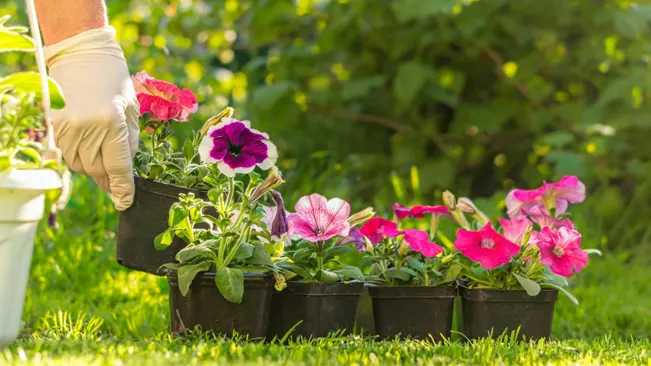
Petunias are annual plants, which means they complete their life cycle in one growing season. They are known for their wide range of colors and patterns and are excellent for use in garden beds, containers, and hanging baskets.
Varieties
There are numerous varieties of petunias, including:
Grandiflora Petunias
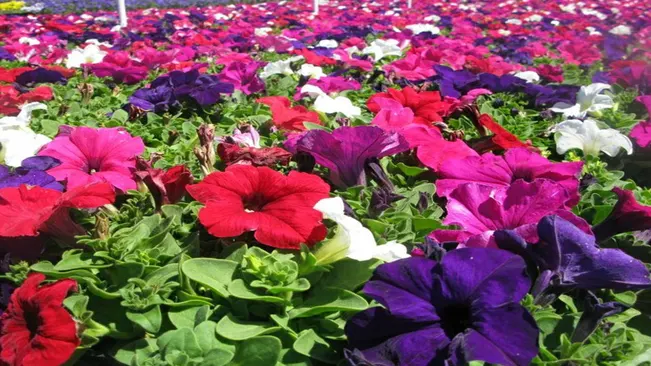
- Characteristics: Grandiflora petunias are known for their large, showy flowers which can be up to 5 inches in diameter. These flowers come in a wide range of colors and patterns, including solids, stripes, and picotee (edged).
- Best Use: Ideal for dramatic displays in garden beds and containers. They make a significant impact when planted in masses.
- Care Tips: These petunias need protection from heavy rain and wind because their large blooms can be damaged easily. Regular deadheading is necessary to keep them looking their best.
Multiflora Petunias
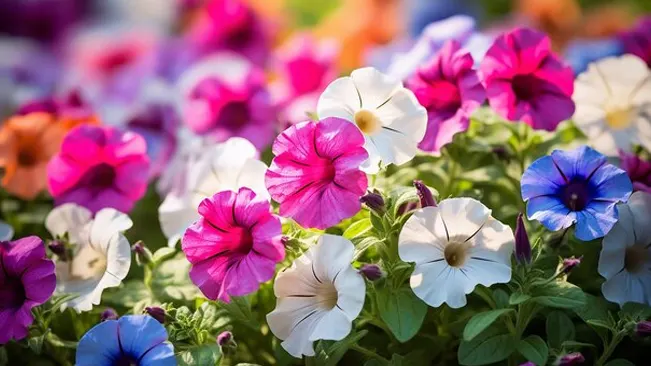
- Characteristics: Multiflora petunias have smaller, but more numerous blooms compared to Grandifloras. They are more tolerant of harsh weather, including rain and wind.
- Best Use: They are excellent for creating a dense, colorful carpet of blooms. Perfect for use in flower beds, borders, and large containers.
- Care Tips: They are somewhat easier to maintain than Grandiflora petunias, requiring less deadheading and are less likely to be damaged by rain.
Milliflora Petunias
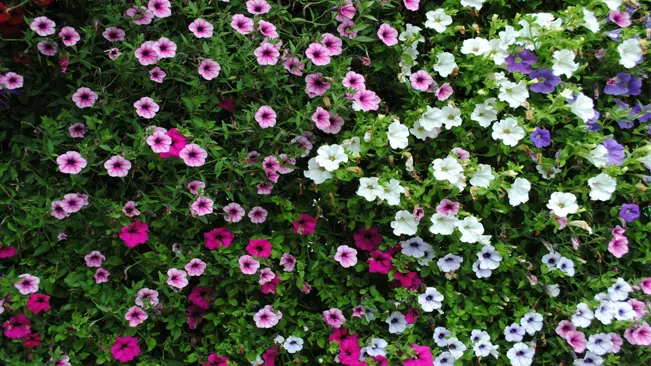
- Characteristics: Milliflora petunias are the smallest variety, with blooms typically about 1 to 1.5 inches in diameter. They produce a multitude of petite flowers over the entire plant.
- Best Use: These are perfect for small spaces, hanging baskets, and mixed containers where they can be appreciated up close.
- Care Tips: Milliflora petunias are relatively low maintenance, requiring only regular watering and occasional fertilization. They do not require deadheading.
Wave Petunias
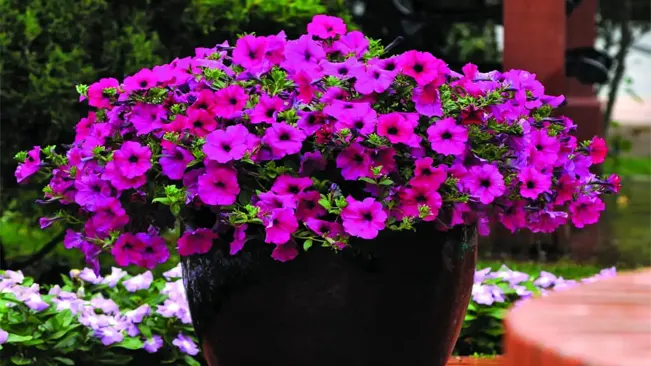
- Characteristics: Wave petunias are known for their vigorous growth and trailing habit. They can spread out over a large area, with a single plant covering several feet.
- Best Use: Ideal for ground covers, hanging baskets, and as a spiller plant in containers. They fill in areas quickly and provide a blanket of color.
- Care Tips: These petunias are relatively easy to care for. They need regular watering and fertilization but less frequent deadheading than other varieties. They are great for gardeners looking for low-maintenance options with high impact.
Planting Petunias
When to Plant
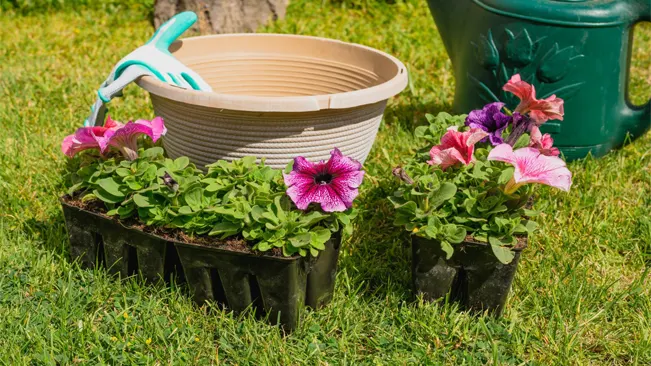
Petunias are warm-weather plants that are sensitive to frost and cold temperatures. The ideal time to plant them is in the spring once the threat of frost has passed. This period varies depending on your geographical location:
- In colder climates, this might be later in spring, often in late April or May.
- In warmer regions, planting can occur as early as March.
Why Timing Matters
Planting petunias at the right time is crucial for a few reasons:
- Frost Sensitivity: Petunias are damaged by frost. Planting them too early when frost is still a possibility can kill or severely damage the plants.
- Temperature Requirements: Petunias require warmer soil and air temperatures to grow effectively. They thrive in conditions where the daytime temperatures are consistently above 60°F (15°C).
Steps for Planting Petunias
- Preparation: Before planting, ensure the soil is well-prepared. Petunias prefer well-draining soil that’s rich in organic matter. If necessary, amend the soil with compost or a well-balanced fertilizer.
- Spacing: When planting petunias, leave about 10 to 12 inches (25 to 30 cm) of space between each plant. This spacing allows for adequate air circulation and room for growth.
- Depth: Plant petunias at the same depth they were growing in their nursery pots. Planting them too deep can lead to stem rot.
- Watering: After planting, water the petunias thoroughly. They need a consistent supply of moisture, especially in the first few weeks after planting, to establish a strong root system.
- Sunlight: Choose a planting location that receives full sun. Petunias need at least 6 hours of direct sunlight daily to bloom profusely.
Choosing a Location
When selecting a location for planting petunias, here are a few tips to keep in mind:
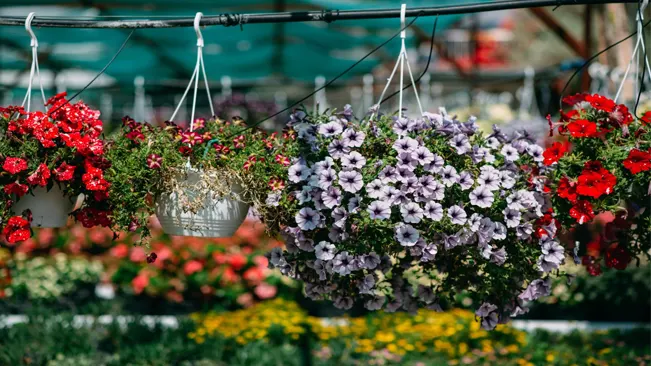
- Garden Beds and Borders: If planting in a garden bed, ensure the area receives ample sunlight throughout the day. South or west-facing locations are typically ideal.
- Containers and Hanging Baskets: For petunias in containers or hanging baskets, position them on patios, balconies, or other areas where they can receive sufficient sunlight. Remember, you can move containers to optimize sun exposure.
- Avoiding Shaded Areas: Steer clear of planting petunias under large trees or in the shadow of buildings for extended periods. Limited sunlight will lead to leggy plants with fewer flowers.
Soil Requirements
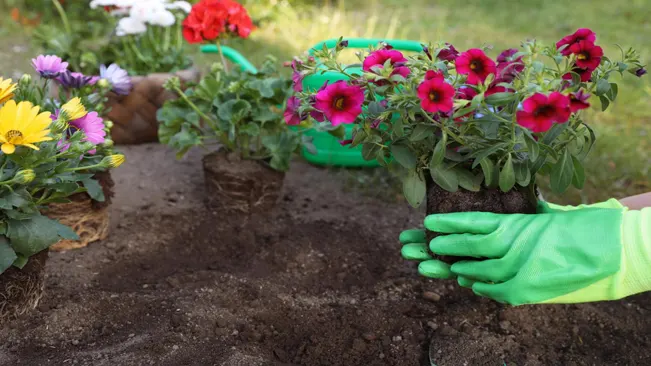
- Amending with Compost:
- Before planting, mix in a generous amount of compost. Compost improves soil texture, provides a range of nutrients, and enhances the soil’s ability to retain moisture without becoming waterlogged.
- If you’re planting in a garden bed, work the compost into the soil to a depth of about 6 to 8 inches.
- Using Balanced Fertilizer:
- If your soil is less fertile, consider using a balanced, slow-release fertilizer. A fertilizer with an equal balance of nitrogen, phosphorus, and potassium (e.g., 10-10-10) is ideal for petunias.
- Slow-release fertilizers provide a steady supply of nutrients over a longer period, which is beneficial for the sustained growth of petunias.
- Checking Soil pH:
- Petunias prefer slightly acidic to neutral soil (pH between 6.0 and 7.0). If necessary, you can modify the soil pH with lime (to raise the pH) or sulfur (to lower the pH).
- Preparing Container Soil:
- If you’re planting petunias in containers, use a high-quality potting mix that ensures good drainage. Avoid using garden soil as it can be too heavy and may not drain well in a container setting.
Caring for Petunias
Watering
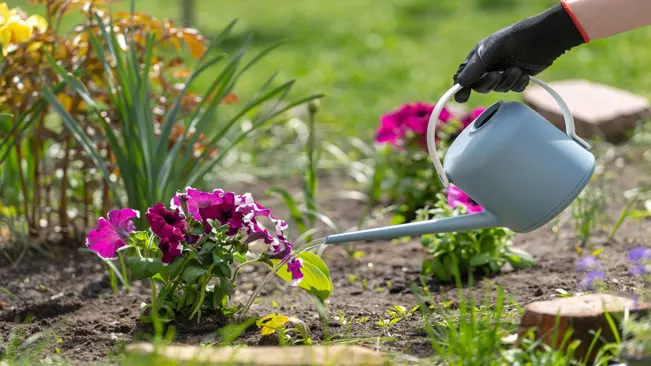
- Soil Moisture Check: Before watering, check the top inch of soil. If it feels dry, it’s time to water. This simple check helps avoid overwatering.
- Morning Watering: Ideally, water petunias early in the morning. This allows the plants to fully utilize the water throughout the day and prevents fungal diseases that can occur if plants remain damp overnight.
Watering Technique
- Water at the Base: It’s best to water the soil at the base of the plant rather than overhead watering. This method reduces the risk of leaf diseases and directs the water to the roots where it’s most needed.
- Deep Watering: Encourage deep root growth by watering deeply and thoroughly rather than frequent shallow watering. This helps the plants become more drought-tolerant.
Adjusting to Weather Conditions
- Hot and Dry Climates: In hot, dry conditions, petunias may need to be watered daily, especially if they are in containers or hanging baskets.
- Humid or Cooler Climates: In humid or cooler weather, petunias require less frequent watering. Always check the soil moisture level to guide your watering schedule.
Container Watering
- Drainage: Ensure containers and hanging baskets have good drainage to prevent water from pooling at the roots.
- Frequent Watering: Container-grown petunias typically dry out faster than those planted in the ground, so they may require more frequent watering.
Fertilization
Petunias are heavy feeders, meaning they require a consistent supply of nutrients to produce their abundant and colorful flowers. Fertilization provides these essential nutrients, which might not be sufficiently available in the soil, especially in container-grown plants.
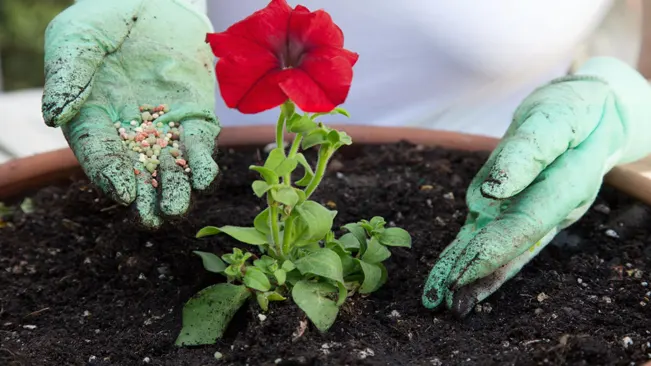
Types of Fertilizers
- Water-Soluble Fertilizers: These are quickly absorbed by plants and are ideal for giving petunias a quick nutrient boost. They are typically applied by mixing with water and using it to water the plants.
- Slow-Release Granular Fertilizers: These fertilizers release nutrients slowly over time and are ideal for long-term nourishment. They are especially useful for garden-planted petunias.
- Organic Options: Organic fertilizers like compost or fish emulsion can also be beneficial. They not only feed petunias but also improve soil health.
Pruning and Deadheading
Deadheading
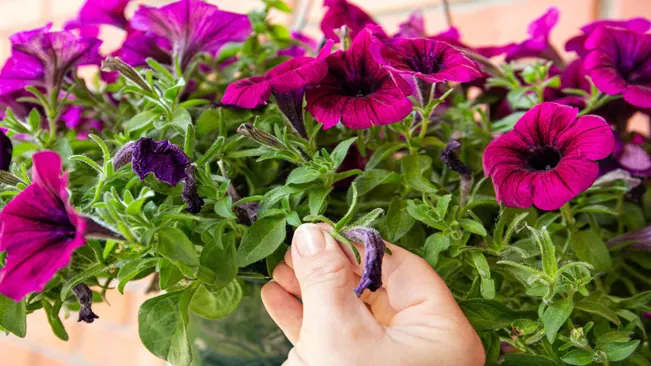
- What is Deadheading? Deadheading involves removing spent or wilted flowers. It prevents petunias from spending energy on seed production and encourages the plant to produce more blooms.
- How to Deadhead Petunias Gently pinch off or use scissors to cut the faded blooms at the base of the flower stem. Be sure to remove the entire flower head, including any developing seed pod at the base.
- Frequency of Deadheading Regular inspection of the plant is key. Deadhead as soon as you notice wilted or faded flowers. During peak blooming periods, this might be necessary every few days.
Pruning
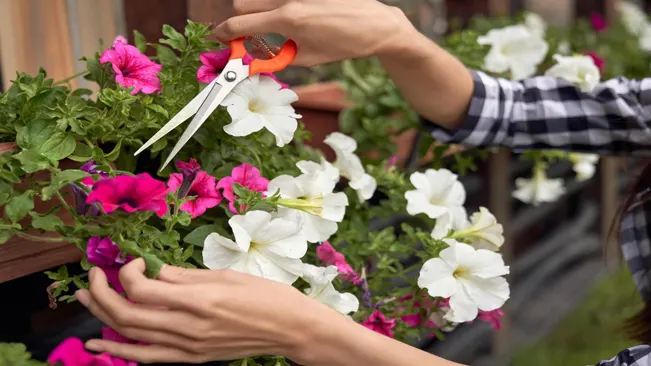
- Purpose of Pruning Pruning petunias helps in shaping the plant, encouraging bushier growth, and removing any leggy or overgrown stems.
- How to Prune Petunias Use clean, sharp scissors or pruning shears. Cut back overgrown or leggy stems to about half their length or to a point where you see new lateral growth (side shoots). This encourages the plant to grow more stems sideways, leading to a fuller appearance.
- Best Time for Pruning Midseason is a great time to prune petunias. This helps rejuvenate plants that might have become leggy or sparse, especially after a flush of blooms.
Common Problems
Pests
- Aphids: These small, sap-sucking insects are among the most common pests affecting petunias. They can cause the leaves to curl and can also transmit diseases. Aphids are often found on the underside of leaves.Control: Use a strong stream of water to dislodge aphids from plants, or apply insecticidal soap or neem oil. Encouraging beneficial insects like ladybugs, which feed on aphids, can also be effective.
- Spider Mites: These tiny pests are hard to see but can cause significant damage. They suck plant juices, leading to yellowing or speckled leaves.Control: Like aphids, a strong water spray can help remove spider mites. Insecticidal soap or neem oil can also be used. Keeping the plants well-watered and reducing stress can make them less susceptible to spider mites.
- Whiteflies: These small, white, flying insects cluster on the underside of leaves. They suck sap and secrete a sticky substance called honeydew, which can lead to sooty mold.Control: Yellow sticky traps can catch adults. Insecticidal soap or neem oil can help control infestations. Consistent monitoring is key to control.
Diseases
- Root Rot: This is often caused by overwatering or poor drainage. The roots of the plant start to decay, leading to a decline in the overall health of the plant.Prevention: Ensure good soil drainage and be cautious not to overwater. Let the top inch of soil dry out between waterings. If using containers, make sure they have adequate drainage holes.
- Mildew: Powdery mildew presents as a white, powdery substance on leaves. It thrives in humid conditions with poor air circulation.Prevention and Control: Improve air circulation around plants by spacing them properly and pruning if necessary. Fungicides can be used, but it’s best to focus on preventive measures.
- Botrytis Blight: This fungal disease can cause gray mold on flowers, leaves, and stems, especially in cool, wet weather.Control: Remove and dispose of infected plant parts. Improve air circulation and reduce humidity around the plants. Fungicides may be necessary in severe cases.
General Tips for Pest and Disease Control
- Regular Monitoring: Regularly inspecting your petunias can help catch pests or diseases early, which is crucial for effective control.
- Good Cultural Practices: Healthy plants are less susceptible to problems. This includes proper watering, fertilizing, and pruning.
- Cleanliness: Remove debris and fallen leaves around petunias to reduce the risk of disease.
Conclusion
Growing petunias successfully hinges on providing them with ample sunlight, well-drained soil, and regular watering without overdoing it. Regular fertilization and deadheading are essential to encourage continuous blooming and maintain their vibrant appearance. By staying vigilant against common pests and diseases and practicing good plant care, gardeners can enjoy the lush, colorful beauty of petunias throughout the growing season.
FAQs (Frequently Asked Questions)
- What is the best time to plant petunias?
- Plant petunias in the spring after the last frost, as they thrive in warm weather.
- Plant petunias in the spring after the last frost, as they thrive in warm weather.
- Do petunias need full sun or shade?
- Petunias prefer full sun, requiring at least six hours of direct sunlight daily to flourish.
- Petunias prefer full sun, requiring at least six hours of direct sunlight daily to flourish.
- What type of soil is best for petunias?
- Petunias grow best in well-drained, fertile soil. Amend the soil with compost or a balanced, slow-release fertilizer for optimal growth.
- Petunias grow best in well-drained, fertile soil. Amend the soil with compost or a balanced, slow-release fertilizer for optimal growth.
- How often should I water petunias?
- Water petunias regularly to keep the soil consistently moist, but avoid overwatering. Reduce watering in cooler or rainy periods.
- Water petunias regularly to keep the soil consistently moist, but avoid overwatering. Reduce watering in cooler or rainy periods.
- Do I need to fertilize petunias?
- Yes, fertilize petunias every few weeks with a water-soluble fertilizer to support continuous blooming.
- Yes, fertilize petunias every few weeks with a water-soluble fertilizer to support continuous blooming.
- How do I make petunias bushier and fuller?
- Regularly pinch off the tips of the stems and deadhead wilted flowers. This encourages branching and results in a bushier plant.
- Regularly pinch off the tips of the stems and deadhead wilted flowers. This encourages branching and results in a bushier plant.
- Can petunias be grown in containers?
- Absolutely! Petunias are excellent for containers, hanging baskets, and window boxes. Just ensure the container has good drainage.
- Absolutely! Petunias are excellent for containers, hanging baskets, and window boxes. Just ensure the container has good drainage.
- What are common pests and diseases that affect petunias?
- Aphids and other pests can be a problem, and petunias can suffer from fungal diseases like root rot and mildew, particularly if overwatered or in poor-drainage areas.
- Aphids and other pests can be a problem, and petunias can suffer from fungal diseases like root rot and mildew, particularly if overwatered or in poor-drainage areas.
- Can I grow petunias from seeds?
- Yes, you can start petunias from seeds indoors about 10-12 weeks before the last frost date. However, they can be slow to germinate and grow, so many gardeners prefer buying young plants.
- Yes, you can start petunias from seeds indoors about 10-12 weeks before the last frost date. However, they can be slow to germinate and grow, so many gardeners prefer buying young plants.
- How long do petunias bloom?
- With proper care, petunias can bloom from late spring until the first frost in autumn. Deadheading and regular fertilization help prolong their bloom period.

Kristine Moore
Forestry AuthorI'm Kristine Moore, a seasoned garden landscaping professional with over 30 years of experience. My extensive career has been dedicated to transforming outdoor spaces into stunning, sustainable landscapes. With a deep understanding of horticulture, design principles, and environmental stewardship, I have become a respected figure in the field, known for creating harmonious, visually appealing, and eco-friendly gardens. My commitment to excellence and continuous learning in landscaping trends and techniques has solidified my reputation as an expert in garden design and implementation.

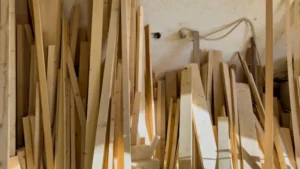







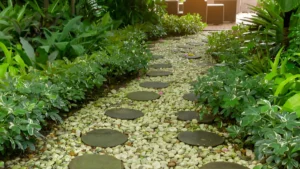



Leave your comment